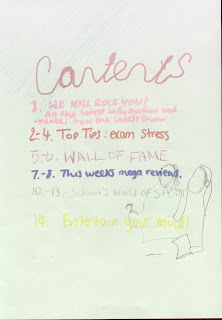1. What feature artist would you like to read about?
2. What is your preferred music magazine to read?
Q
Rolling Stone
Kerrang!
Mojo
NME
Uncut
Classic rock
Alternative
Blender
Clash
Other please state: ____________
3. Which of these cover layouts do you like the best? Why?
4.what attracts you to a music magazine?
Artist named
Cover artist (photograph)
The quality of the photography on the front cover
The colour scheme
The title of the magazine
Incentives mentioned on the cover
5. Which type of artist do you expect to find on the cover of your favourite magazine?
6. List your top favourite artists (maximum of 5)?
7. What is your prefered colour scheme for a magazine?
8. I like ____ font on the cover.
[rounded, sharp, arty]
9. What features do you like to find in a music magazine?
10. What do you like the articles to be about?
11. How do you like the contents page? Blocky or image dominated?
12. In what way do you prefer a double page feature
atricle to be set out?
13. What interests you to an article from the contents page?
14. What incentives would you expect with your chosen magazine?
15. Do you like it when special features create a special issue?
16. Do you prefer natural or posed photos?
17. Do you prefer LED lighting in photos(gig photos) or natural lighting?
18. Do you prefer to see bands on the front cover or single artists?
19. Would you like to see a female artist on the front cover for a change?
20. How much would you pay for a music magazine?
£1
£2
£3
£4
£5+
£1
£2
£3
£4
£5+
21. Is there any reason why you would not buy a music magazine? If so what?











